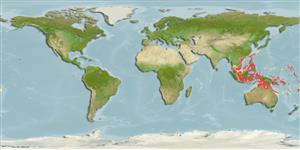>
Kurtiformes (Nurseryfishes, cardinalfishes.) >
Apogonidae (Cardinalfishes) > Apogoninae
Etymology: Rhabdamia: Greek, rhabdos = stick + Greek, amia = a kind of shark (Ref. 45335); spilota: Name from Greek 'spilota' meaning spot, referring to the distinctive spot above the pectoral fin..
Environment: milieu / climate zone / depth range / distribution range
Écologie
marin récifal; profondeur 20 - 55 m (Ref. 11894). Tropical
Indo-West Pacific.
Taille / Poids / Âge
Maturity: Lm ? range ? - ? cm
Max length : 6.0 cm TL mâle / non sexé; (Ref. 48635)
Épines dorsales (Total): 7; Rayons mous dorsaux (Total): 9; Épines anales 2; Rayons mous anaux: 12; Vertèbres: 24. This species is distinguished by having D VI-I,9; A II,12; pectoral rays 13; total gill rakers on first arch 7+22; preopercular margin and ridge finely smooth; body very slender, depth 3.7-3.8 in SL; body semi transparent, whitish in life with 3-4 small dark spots midlaterally on operculum and above basal part of pectoral fin (Ref. 11894).
Swims in tight pairs (Ref. 48635); observed to occur in large aggregation around rocky outcrops with gorgonian fans and crinoids on steep slopes. Swims actively during the day above isolated coral heads to feed on zooplankton (Ref. 48635).
Life cycle and mating behavior
Maturité | Reproduction | Frai | Œufs | Fécondité | Larves
Distinct pairing during courtship and spawning (Ref. 205).
Yoshida, T., K. Mabuchi and H. Motomura, 2018. Rhabdamia novaluna, a new species of cardinalfish (Perciformes: Apogonidae) from the western Pacific Ocean, with comments on the synonymy of Rhabdamia gracilis. Ichthyol. Res. 66(1):129-139.
[First published online, pp. 1-11, 26 Oct. 2018; volume, issue and pages added on 17 Feb. 2019.] (Ref. 129520)
Statut dans la liste rouge de l'IUCN (Ref. 130435)
Menace pour l'homme
Harmless
Utilisations par l'homme
Plus d'informations
RéférencesAquacultureProfil d'aquacultureSouchesGénétiqueElectrophoresesHéritabilitéPathologiesTraitementNutrientsMass conversion
CollaborateursImagesStamps, Coins Misc.SonsCiguateraVitesseType de nageSurface branchialeOtolithesCerveauxVision
Outils
Articles particuliers
Télécharger en XML
Sources Internet
Estimates based on models
Phylogenetic diversity index (Ref.
82804): PD
50 = 0.5156 [Uniqueness, from 0.5 = low to 2.0 = high].
Bayesian length-weight: a=0.01122 (0.00528 - 0.02384), b=3.10 (2.92 - 3.28), in cm total length, based on LWR estimates for this (Sub)family-body shape (Ref.
93245).
Niveau trophique (Ref.
69278): 3.4 ±0.45 se; based on food items.
Résilience (Ref.
120179): Haut, temps minimum de doublement de population inférieur à 15 mois (Preliminary K or Fecundity.).
Fishing Vulnerability (Ref.
59153): Low vulnerability (10 of 100).
